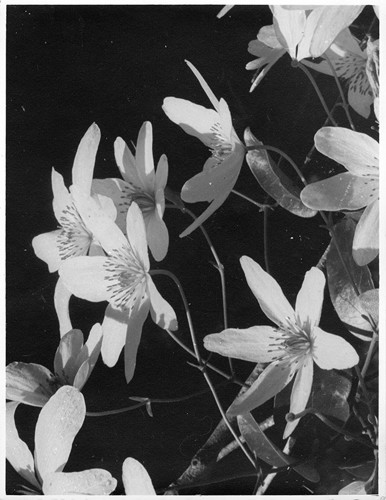
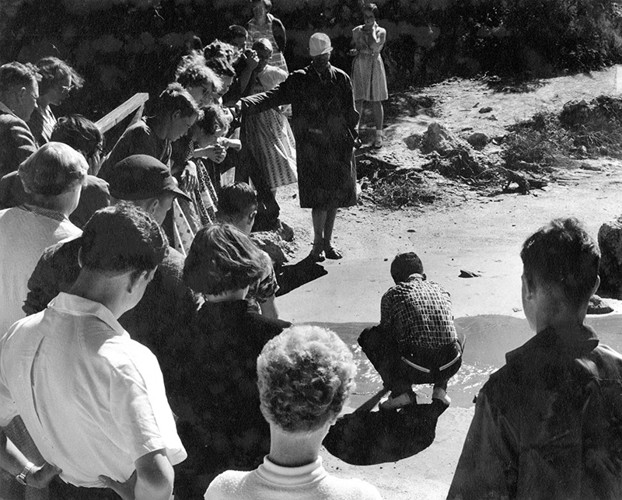
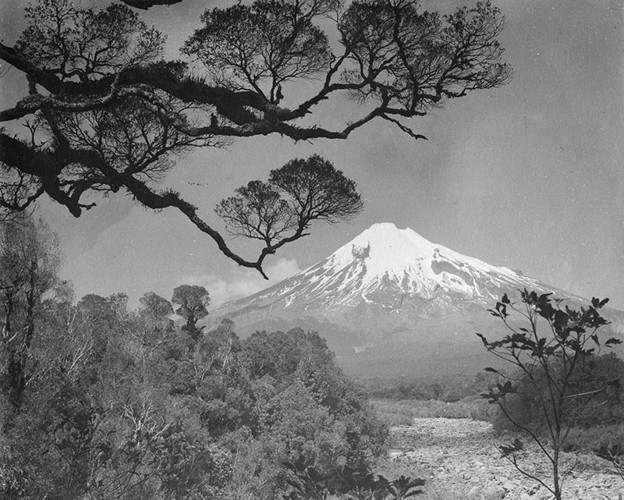
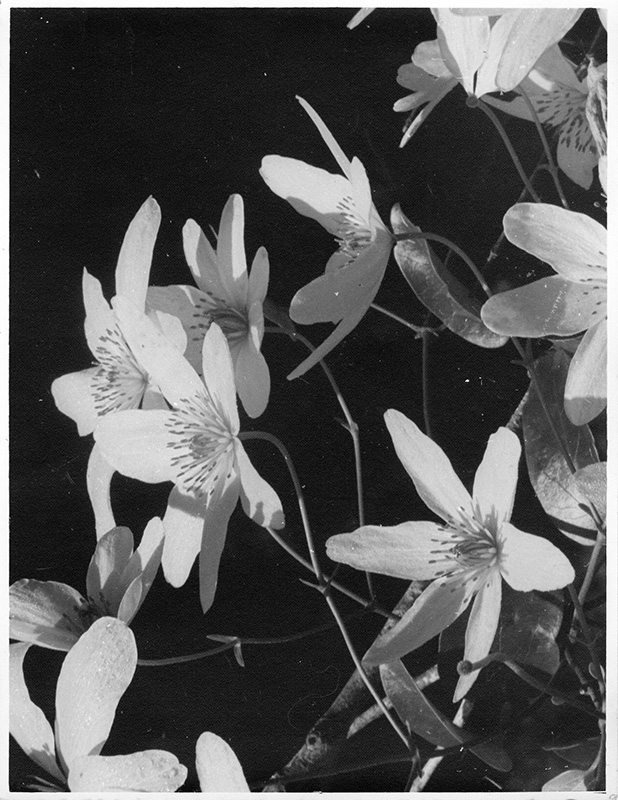
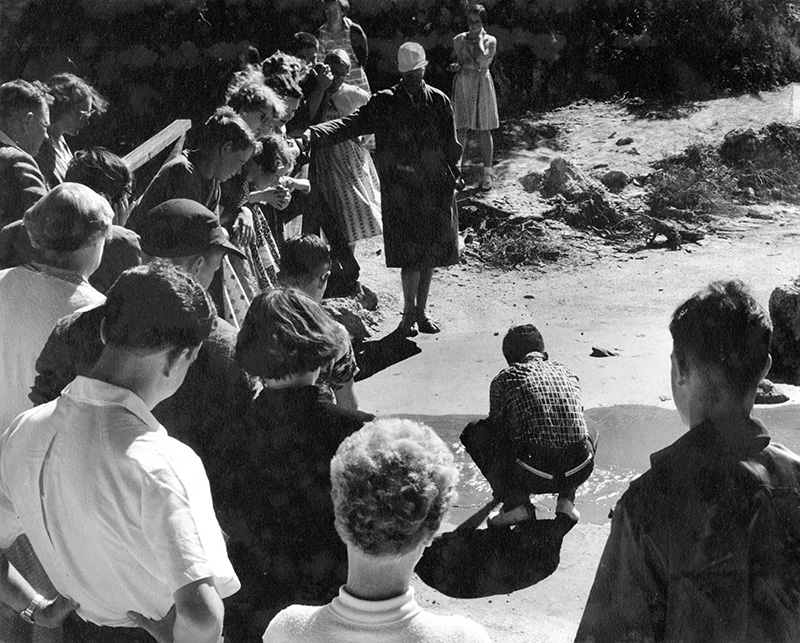
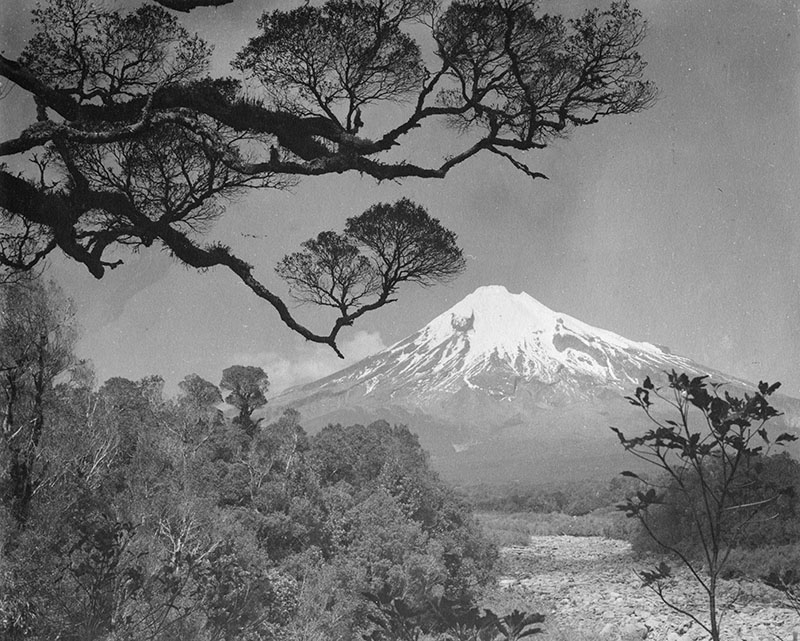
If every picture tells a story, then Robert Wells has thousands upon thousands of tales to tell. With the turning pages of his folios and albums, the 98-year-old's (in 2004) life pours out in torrents, just like the many rivers he has captured on film.
From 1919 until 1996, Robert photographed the beauty of New Zealand, a hobby he was born to embrace. His pictures continue to appear in glossy coffee table books, on postcards, in magazines, advertisements, newspapers, education books, postage stamps and pictorial calendars. While he has travelled New Zealand with camera and tripod, Robert Wells is now mostly confined to his New Plymouth home.
Closing in on a century of living, this once-vigorous young man is a frail figure. He lies in a blue recliner chair in his lounge, with windows closed and heater on, even though it’s summer. His voice is thin, high and scratchy like a gramophone record, and both hearing and sight are failing. Robert's once fine-tuned eyes see double images, meaning he has to watch television with one eye closed.
While his body is wearing out, Robert's mind remains clearly focused on a life well lived. Every detail is there - dates, costs, names, places - as if he is doing a stock-take of the past. The good times, the disappointments, the successes, the losses, people's kindnesses, childhood upsets, things learnt by rote… these all come tumbling out.
Effortlessly, he reels off whole verses of Longfellow's Kambalu, a poem about a Tartar king, memorised at Hāwera Main School in 1918. Incredibly, these words have been in his head for more than 85 years.
Robert Ernest Wells came into the world at Pātea on 16 October 1905. His parents were Elizabeth Frances (nee Cole) and Ernest Edward Wells. "My father was a photographer in Pātea until 1917 then he sold out, he gave up that and moved up to Hāwera to open a cycle shop on the corner of Victoria and High streets." While his dad's focus on photography lessened, Robert zoomed in on the art form.
To support his 14-year-old son's passion, Ernest Wells bought him a Kodak box brownie. The simple camera produced prints one size smaller than an average postcard. "Right from the start I was not looking for snapshots; I was looking for pictures with it... interesting things, places and scenes, never buildings very much, and people never," Robert says.
As a teenager, he regularly won his section of the annual Hāwera A&P Show photography contest. Robert went to great lengths to take the best-possible pictures and even pedalled in search of snow-covered paddocks around the mountain. "I used to ride up from Hāwera to take photos with this small camera. I know my hands would be absolutely frozen on the handlebars riding back to Hāwera."
Ernest Wells taught his son how to develop films, including daylight prints that harnessed the rays of the sun.
Hāwera chemist George Westwood also helped Robert in his hobby. "He was a very good friend and he let me have the use of his darkroom for taking off enlargements when they'd done their developing and printing for the day," Robert says. "I'd pay him for the chemicals and the things I used. He had a very old enlarger that was an antique…a horizontal thing and the condensers were huge glass things about that round," he says, hands curved to the size of car headlights.
When George upgraded to a vertical enlarger, he gave Robert the old one. "I had it at home, I had it for years." The horizontal enlarger, dated 1900, looks like a cross between a train and an accordion, it is now part of the Puke Ariki collection.
Robert bought another antique when he was at teachers' training college in Wellington. After spending 1923 and 1924 at Tawhiti School doing the required time as a pupil-teacher, he headed to the capital for two years.
One day, when wandering down Willis Street, he looked into the window of a pawnbroker's shop and saw a Thornton Picard field camera on sale for just five pounds. "I thought, 'heavens, that's a gift absolutely'," Robert exclaims, as if he is standing there, peering through glass.
Determined to buy the ‘Rolls Royce of cameras’, he sold his half-plate camera to a mate for the necessary money, but the pawnbroker put the price up to £7. Grudgingly, Robert scrabbled together his meagre finances. Back then, male teachers' college students received £9 each month, with £6 handed over straight away for board and lodging. "We had to live on £3 a month for the whole two years there. The girls got less than £9, so I don't know how they managed."
Somehow, Robert managed to buy the whole-plate camera. "It took 8½ (-inch) by 6½ (-inch) photographs, same as my father had had and it was a big bulky thing. I had to get a chap in Hāwera, who made sandals and all-leather goods, to make straps on it so I could have it round my waist and over my back. I could take super photos with that - better than the other one, because this was super quality."
During his teacher-training years, Robert took pictures in the Wellington Botanical Gardens and also snapped photographs of the college's staff and students. He reckons his hobby counted against him because tutors saw he aimed for perfection in his photography, but just did what was necessary to pass his teaching studies.
After he completed his training, it took Robert until September 1927 to get a full-time job. And when he did, the young man found himself 16 miles (nearly 26 kilometres) up the Mōkau River. Robert spent five years teaching at Mangatoi School, which was only accessible by boat. In fact, the location was so isolated he received an annual remote allowance of £20 - double that of most other remote allowances.
Four months after leaving the river, Robert's father died. At the time, the younger Wells was working at Kirihau Road School towards the mountain inland from Ōākura. "New Plymouth Sash and Door had a mill up there and it was the children of the mill workers who attended the school," says Robert. He was given just three days off to head for Hāwera to organise the funeral for his dad, a timeframe he still believes was too short.
Next stop was another rural school, closer to south Taranaki. This school was on, and named after, a road where many years later Robert took his favourite-ever photo. As the pages turn on his 13th folio (the other 12 are in the Alexander Turnbull Library), he says: "There's one at the back I'm very proud of - it's taken at the end of Arawhata Road with the leaves of the cabbage trees and the mountain in the background."
Continuing on his trail of country schools, in the late 1930s Robert taught at Mairoa near Piopio. Two major events happened in those years - one terrific, the other terrible.
First the good news, a story about an old flame. In 1937, Robert married Zeila Aroha Gillman Walker, who was also born in Pātea. As youngsters, the photographer's son and chemist's daughter used to live across from each other. "His (the chemist's) shop was the on the ground floor and they lived in the upstairs part. When we were pre-schoolers we played in the street outside."
In 1910, the pharmacy burnt down, cooling the youngsters' early friendship. Despite the years, Robert replays the event in his mind, seeing six firemen working the water pump, three on each side. "They couldn't turn it on to the house on fire. The butcher shop, Ramsbottom, was just across the street... the paint was blistering on the side of the house. They were turning the hose on that so that didn't catch on fire." After flames claimed the chemist building, the Walker family moved into the main street of Pātea. "That was the end of us playing together as kids," Robert says. "Then we moved away from Pātea up to Hāwera and I never saw her again until about 20 years later. I went down to Whanganui and we met, and we married. I was 32 and she was 34 when we married, on the 29 December 1937."
The bad news is something that still causes Robert to shake his head - and will make historians curse. At the time he and Zeila married Robert had to decide what to do with his photographic collection. "I had some hundreds of glass negatives stored in my bedroom and the names of everything and all the rest of it."
He looked at the facts. The Hāwera house was to be sold, he had nobody to look after his negatives, no room in his Austin 7 car to transport them to the King Country and no schoolhouse came with the Mairoa job. So Robert took a drastic step. "I dug a great big hole at our house there. I almost wept. I had to throw out box after box after box of negatives. I managed to save about half a dozen and I couldn't save any more. That was that, and I filled it in... Everything went."
The truth is, not all was lost. There were still albums of actual photographs and Robert continued taking pictures, still pushing himself to shoot exceptional images.
After Mairoa, he was transferred north of Auckland. This came about because of health reasons relating to the ongoing effects of a chill and the stern words of a doctor, who told Auckland education authorities that he would not be responsible for Robert Wells' life if they didn't relocate him to a warmer climate.
For most of the 1940s, the Wells' family lived in Northland, with Robert working first at Parakao School, west of Whāngārei, and then at Aratapu School, just south of Dargaville. Being a teacher in a rural school was considered a necessary occupation and so Robert was exempt from fighting in World War Two.
Near the end of his Northland years, he became extremely ill. For a week, he had a burning drip, drip, drip in his gut, finally forcing doctors to operate. They gave him a spinal anaesthetic and so he was awake and aware when they discovered the source of his pain - a swollen appendix that was quickly removed. "It was like a great big pink sausage," he says. The medical people asked Robert if he wanted it as a keepsake in a jar. He remembers his swift reply: "What a repulsive-looking thing – no, throw it away." It was about then that a nurse noticed it was perforated and doctors realised why Robert had been experiencing that infernal internal drip. It took him many long weeks to recover from the resulting peritonitis.
After Northland, the Wells family returned to Taranaki. Back on home turf, Robert taught for two years at Te Kiri School, two years as first assistant (deputy principal) at Waitara Central and two years as headmaster at Waitara East School.
While teaching at Waitara, the Wells' family lived at Fitzroy in New Plymouth, so Robert was amazed when some boys came visiting on their bikes one Saturday morning in 1951. "I said, ‘What are you chaps doing down here?’ They said, ‘We thought we'd come for a ride to see you sir, to have a chat’, and they did that day after day until practically the end of the year."
He was just as popular at Fitzroy School, where he spent the final years of his teaching career, from 1955 to 1967. One morning he opened the front door of his Richmond Street house to see a couple of children waiting to escort him to school. The next day there were more and, in the end, about 30 children flanked Robert each morning.
Near the end of one school year, he broke his Achilles tendon. After he got out of hospital, he began to get daily visits from his students. To keep him up with the goings on, a group of five boys would visit him one night and five girls the next night. They alternated their visits until school broke up for the Christmas holidays.
In the final years of his life, Robert lies back on his recliner and replays cherished memories over and over in his mind. One of them is particularly mouth-watering.
Sometime during those 13 years he spent as first assistant at Fitzroy (for once Robert can't pin down the date), Cadbury Fry Hudson held a nationwide competition for the best photograph featuring a large block of chocolate. With the help of Robert junior, the skilled photographer set the scene. On Lake Rotoiti at Rotorua, he got his son to climb up a trig station and pose with a block of Dairy Milk.
The image was a winner. "The prize was a carton of all their products, no money," Robert says, savouring the memory. “They had to get it sent up by ship and when I spread it out on our dining room table and photographed it with the camera, it covered the whole table. There were miles of biscuits and chocolate blocks - absolutely marvellous."
Robert still loves chocolate. In the kitchen is a stack of Dairy Milk blocks and beside his recliner is an ever-present bowl of rich brown squares, offered generously to visitors.
Other recollections of his life have left a bad taste in his mouth. Robert still believes Taranaki education authorities made him suffer for his interest in photography. "I was punished for 35 out of my 45 years. The only pleasures I had in my 35 years were my friendships with other teachers and my pupils. It was only when I was 62 that my life changed into something exciting, enjoyable and rewarding," he says, referring to his after-life as a photographer.
When Robert retired from teaching, his appetite for taking pictures grew until he was, in effect, a full-time amateur photographer. From 1970 to 1980, he was one of a select few freelancers working for Wilson & Horton. That's when a former pupil came to light.
In 1974, photographer Rob Tucker was the assistant illustrations editor at the New Zealand Herald and a man called Don Lochore was the chief illustrations editor for Wilson & Horton (owners of the newspaper). "Michael Horton loved the [Auckland] Weekly News, but it never made any money so they scrapped it." says Rob
However, the annual version continued to be produced every Christmas. This book was filled with beautiful pictures of New Zealand, taken by four or five of Don Lochore's pet photographers nationwide. "One of them was a Bob Wells of New Plymouth. I said 'I'm sure that's my old school master'," Rob says.
Next time he was in Taranaki, Rob looked up his former Standard Four teacher and found he had a whole library of photographic negatives. On request, Robert Wells sent these to people for use in calendars and on postcards.
Young Tucker had a better idea of how the older photographer could make more money from his work, so referred him to Photobank in Auckland. The agency took Robert on in 1982, and now has about 7000 of his pictures on file. "Quite frankly, from the 1960s, '70s and '80s, he was one of the leading landscape photographers in New Zealand, based in New Plymouth," says Rob Tucker.
Even now, Robert Wells' pictures are in demand. In 2003, a German company bought a picture of Lake Hāwea to use in its promotions to get tourists to New Zealand. The photograph is devoid of people, buildings, farms and animals. "It's an empty landscape. The way things are in Europe, it would be something out of this world to see a countryside like that, with no people in it," Robert says.
The 1970s were a boom time for the New Plymouth photographer. In 1974, he was asked by bus tour company Newman's to take photos en-route. With glee, Robert and Zeila headed to the South Island in their own car, taking pictures on the bus trail from Christchurch, through Greymouth, West Coast lakes, Haast, Wanaka, Queenstown, Milford Sound, Central Otago and back to Fairlie in Canterbury.
The commissioned job led to the happy snapper and his wife taking biannual eight-week trips to capture the glory of the South Island in spring and autumn. "And I always took at least 500 photos in those two months," he says. "Those photos are divided between Photobank in Auckland and the Alexander Turnbull Library in Wellington." In the end Robert went south alone.
He lost his Zeila piece by piece through Alzheimer's. After she went into fulltime care, her faithful husband would take her on daily drives to Ōākura, where they would park and watch the sea. "The nurses told me, they said, 'minutes after you leave Zeila and go out of this room, she doesn't know you've been here'. So that was a gift from God to be able to talk the same as you and I are talking now," Robert says. Zeila's lucid spells in her husband's company continued until the day she died on 29 June 1991.
Robert's last trip to the South Island was in 1996, when he was aged 91.
Later in the 1970s, Robert was sought out by publisher Wendy Pye "She came down from Auckland to see me in 1977 and she was sitting on the couch over there," he says, pointing an arthritic finger. "She said, 'I've come down to ask you something very special… I want you to take some photos for me'," says Robert. "I said, 'Why me? I'm only one of dozens of New Zealand photographers', and she said, 'I've been in this game for 15 years, mainly in Christchurch, and I know a lot of photographers and I've chosen you for three reasons: One, I know you are a perfectionist; two, I know you'll get me exactly what I want; and three, I know you are honest'."
Wendy Pye used many of Robert's photographs in her pictorial publication series, Beautiful New Zealand. "My photos were always in double figures," he says. "But the most I ever had were 35 - that was practically a quarter of all the photos in the book."
Even though his photographic collection is of a professional standard, Robert insists he was only ever an amateur. "I never charged people any more than it cost me to take them. Until I gave my transparencies to Photobank it was only a hobby, I never made any money out of it... I covered expenses," he says, listing petrol, accommodation, and the cost of films as the only things he claimed for. He applied those rules to all his photo jobs, delighting in the fact that every trip was like being on holiday.
Robert's work was also published in New Zealand Freelance, the Dairy Exporter Magazine, Tui's Christmas Annual and the Auckland Weekly News and resulting Christmas annuals.
His pictures have even been posted to the far reaches of the earth, via the mail. Six of Robert's photographs have been shrunk to fit on postage stamps. A picture of Franz Josef Glacier appeared on a $1.80 stamp in 1992; one of Lake Wanaka with cloud-streaked sky graced an 80-cent stamp in 1998.
That same year, his images of Ōhakune's big carrot and Fonterra cow in Hāwera were released in the New Zealand town icons series. A picture of the wild Kaikōura coast ended up on a $1.10 stamp, while a tranquil picture of boats mirrored in water at Coromandel was released on a $1.00 stamp in 2003. His photographs have also turned up on phone cards, honey labels, as the backdrop to rugby posters, camping ads and tourist promotions.
When he was 81, Tourism Taranaki employed him to take extensive photographs of the region. Elaine Gill, who was manager of the local government-backed tourism body, remembers watching with trepidation as the elderly man climbed up high to get the best shots. And Robert remained a perfectionist right until his last click of the camera. "I tried to make a picture of something. I moved left or right or up or down, to get the angle that appealed to me most. Sometimes I'd be there 15 or 20 minutes before I'd take the photos. Sometimes I'd kneel down on the ground, take it from ground level," he says. "Actually when I was taking pictures for the postcards all those years, I'd look in the shops to see what someone else had taken of the same place, and I thought, 'if I can't take it better than that, I'm not going to take it'. That was my attitude."
Robert says 2.25-million postcards of his work have sold in New Zealand. The most popular was of a kea, which rang up 40,000 sales. His legacy of work is in safekeeping.
About 6000 individual negatives and pictures are part of the Turnbull collection, says photographic archive curator John Sullivan. "(The) Robert E Wells collection is significant as a comprehensive study of rural life in the North Island from the 1920s to the 1950s, and as an example of the kind of images that presented New Zealand to the world in the period after World War Two," John says. "His images have featured regularly in postcards, calendars, magazine supplements and advertising campaigns since the 1950s, and have played a large part in establishing New Zealand's 'clean green' image."
Fittingly, Robert says the richest prize he ever won was £500 for second prize in the first Agfa photo contest. The theme was ‘All Green’. His runner-up effort was taken in Pukekura Park, looking down through layers of different greens to the fountain lake.
John Sullivan first met the Taranaki man in 1983, having seen his images in a history of Mōkau, sent to the Alexander Turnbull Library. "I first saw his early black-and-white material, taken during his career as a teacher in rural schools throughout northern New Zealand from 1928 until the 1950s. I saw that it filled a significant gap in our holdings - coverage of rural New Zealand from a non-official point of view."
He says Robert's work covers a huge expanse of time, from about 1920 until 1996. John believes this is “an unparalleled range from one photographer (to the best of my knowledge), which has contributed, through publication in various formats from around 1930 to the present day, to New Zealand's view of itself”.
Robert's legacy also lives on in Taranaki. This year, he gifted a selection of his photographs to Puke Ariki. His personal offering is a simple message, one learnt during nearly a century of living. "Be absolutely totally honest, that's the first thing. I've never done anything dishonest in my life; I've never done anything I'm ashamed of."
Even when he's gone, Robert Wells' pictures will endure. "I took them to leave something worthwhile for the country after I have gone." And when Robert does slip away, it's highly likely you may find yourself living with his images for a month at a time. So, as you flip through your scenic New Zealand calendar, look for a wild coast or a serene lake and imagine the person behind the camera lens...
Robert Wells died at age 101 years on Christmas Day 2006.
Puke Ariki Heritage Collection: Robert Wells
LinkPlease do not reproduce these images without permission from Puke Ariki.
Contact us for more information or you can order images online here.